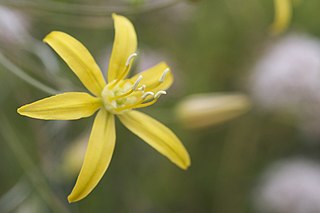
Bloomeria crocea, also known as goldenstar, is a geophyte from southern California and northern Baja California. It is found along hillsides, in grassland and chaparral edges, and in dry flats.
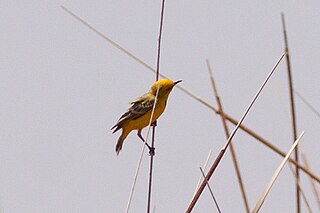
The yellow chat is a small passerine bird endemic to Australia. They are known for their remarkable adaptions that aid their survival in their arid habitat.

Kampong Seila is a district (srok) in southwestern Cambodia, which formerly belonged to Koh Kong province. In January 2009, King Norodom Sihamoni incorporated the district into Sihanoukville province per royal decree, which states: "The administrative boundaries of Sihanoukville municipality and Koh Kong province shall be adjusted by sub-dividing land from Kampong Seila district in whole and partial land of Sre Ambel district in Koh Kong province to Sihanoukville municipality." Officials were assigned to create a "national workshop" process all necessary administrative tasks. The National Institute of Statistics of Cambodia refers in its most recent and preliminary studies to a successful integration of the district, including maps, although concluding statistics and numbers are expected to be available with the next full report. Sihanoukville province's new official domain already runs administration of Kampong Seila district.

Tridacna crocea, the boring clam, crocus clam, crocea clam or saffron-coloured clam, is a species of bivalve in the family Cardiidae. It is native to the Indo-Pacific region. It is occasionally found in the aquarium trade where it is often simply referred to as crocea.

The Mongkol Borey River is a river in Mongkol Borey District in Banteay Meanchey Province in northwestern Cambodia. It flows from the border of Chanthaburi Province of Thailand and runs through Mongkol Borey and neighboring districts. It is a major tributary of the Tonlé Sap.

Triteleia crocea, with the common names yellow triteleia and yellow tripletlily, is a monocot flowering plant in the genus Triteleia.
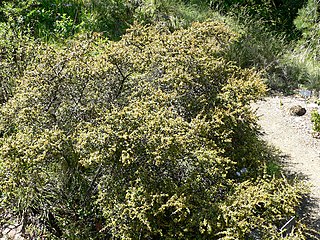
Rhamnus crocea, the spiny redberry, is a species of plant in the family Rhamnaceae. There are two subspecies: Rhamnus crocea subsp. crocea and Rhamnus crocea subsp. pilosa. It is native to California, Arizona, and Baja California.
Changha is a khum (commune) of Ou Chrov District in Banteay Meanchey Province in north-western Cambodia.

Ou Beichoan is a khum (commune) of Ou Chrov District in Banteay Meanchey Province in north-western Cambodia.
Mentzelia crocea, the Sierra blazingstar or saffron blazing star, is an annual wildflower endemic to the Sierra Nevada foothills of California.

Seila is a genus of minute sea snails, marine gastropod molluscs or micromolluscs in the family Cerithiopsidae.

Larimichthys crocea, called the large yellow croaker, the yellow croaker or the croceine croaker, is a species of marine fish in the croaker family (Sciaenidae) native to the northwestern Pacific, generally in temperate waters such as the Taiwan Strait. It lives in coastal waters and estuaries, often in brackish water also, and is found on muddy-sandy bottoms. Males can reach 80 cm, but a common size is 60 cm.

Amanita crocea, the saffron ringless amanita, is a species of Amanita widely distributed in Europe.
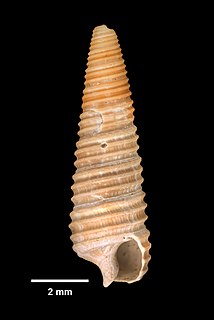
Seila adamsii is a species of minute sea snail, a marine gastropod mollusc or micromollusc in the family Cerithiopsidae.
Iris crocea is a species in the genus Iris, it is also in the subgenus Limniris and the series Spuriae. It is a rhizomatous perennial plant, found in Kashmir. It is cultivated as an ornamental plant. It is also commonly known as Golden Iris or Golden Flag. It was also known as Iris aurea for a long time, before that was regarded as a synonym of Iris crocea.
Seila Law LLC v. Consumer Financial Protection Bureau, 591 U.S. ____ (2020) was a U.S. Supreme Court case which determined that the structure of the Consumer Financial Protection Bureau (CFPB), with a single director who could only be removed from office "for cause", violates the separation of powers. The Court's 5–4 decision, issued on June 29, 2020, recognized that the directorship position was severable from the statute that established the CFPB, allowing the CFPB to continue to operate.
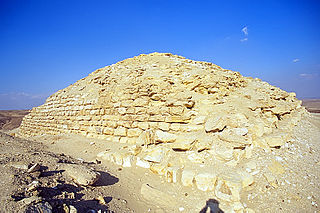
The Pyramid of Seila is one of a group of seven small step pyramids which are very similar to one another, along with the Edfu South Pyramid, the Pyramid of Elephantine, the Pyramid of El-Kula, the Pyramid of Naqada, the Pyramid of Saujet el-Meitin, and the Pyramid of Sinki. These pyramids were all built far from the major centres of Egypt and very little is known about them. The pyramid is located on an outcrop between the Faiyum Oasis and the Nile valley, about 6 km north of the motorway from Wasta to Faiyum. Its builder may have been Snefru, the founder of the Fourth dynasty. It was discovered in 1889/1890 by Flinders Petrie and revisited in 1898 by Ludwig Borchardt.
Collins v. Mnuchin is a pending United States Supreme Court case dealing with the structure of the Federal Housing Finance Agency (FHFA). The case follows on the Court's prior ruling in Seila Law LLC v. Consumer Financial Protection Bureau, which found that the establishing structure of the Consumer Financial Protection Bureau (CFPB), with a single director who could only be removed from office "for cause", violated the separation of powers; the FHFA shares a similar structure as the CFPB. The case extends the legal challenge to the federal takeover of Fannie Mae and Freddie Mac in 2008.













